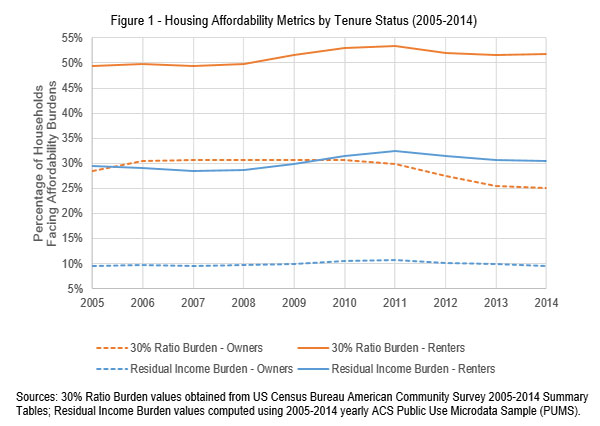Housing Affordability Update

The U.S. Census Bureau's American Community Survey (ACS) indicates that some 18.3 million homeowner households and 20.7 million renter households experienced housing affordability problems in 2014 as measured by the percentage of households that were "cost burdened." A household is considered cost burdened if it spends more than 30 percent of its gross income on housing costs. These are big numbers that demand our attention. However, considering that there are a number of affordability metrics currently used throughout the industry, are these numbers providing the most accurate view of the overall affordability picture, or are we only getting a partial view? Importantly, is there a way to better use the metrics available to accurately assess housing affordability problems?
The "Housing Affordability Primer" from Fannie Mae’s Economic & Strategic Research Group addresses these questions. It contrasts five common housing affordability metrics used in the industry:
- Traditional cost burden metric
- Kutty's residual income approach
- Three home purchase affordability indicators – National Association of Realtors®' Housing Affordability Index (HAI), California Association of Realtors®' Variant HAI, and National Association of Home Builders / Wells Fargo's Housing Opportunity Index
In comparing these metrics, the Housing Affordability Primer allows us to identify which affordability indicators may be insightful for different facets of housing affordability while stressing that no single measure can give us a complete view of the matter. The analysis focuses on housing affordability in terms of households' ability to cover housing costs at given income levels, as opposed to households' ability to access mortgage credit.
As an illustration of the widely varying perspectives provided by different affordability measures, consider a comparison between the traditional cost burden metric and Kutty's residual income approach.1 The residual income approach deems that a household faces an affordability problem if the monthly income left over after covering all housing costs is less than the amount necessary to purchase a minimum level of non-housing-related items. Kutty defines minimum non-housing consumption as two-thirds of the U.S. Census Bureau's poverty threshold. Figure 1 shows that although both metrics indicate consistently higher rates of affordability problems for renters than for homeowners, the residual income metric estimates markedly fewer affected households than the traditional cost burden measure, regardless of tenure status. In 2014 the traditional cost burden measure indicated that some 9 million more renter households and 11 million more homeowner households faced affordability challenges than the residual income metric.2 These two metrics also differ regarding the distribution of affordability concerns by income. While both measures show lower-income households tend to face more affordability challenges, the residual income approach shows the distribution of households with affordability concerns is more skewed toward these lower-income households than the traditional cost burden metric.

The comparison above provides only a hint of the many complex challenges associated with measuring the extent and nature of the nation's housing affordability problems. Thus, a comprehensive understanding of housing affordability's multiple measures is essential for an informed discussion on the issue.
Nuno Mota
Economist
Economic and Strategic Research Group
November 12, 2015
1 Kutty, Nandinee. 2005. "A new measure of housing affordability: Estimates and analytical results." Housing Policy Debate, 16(1): 113-142.
2 Computations based on ACS PUMS 2014 sample which excludes: individuals living in institutions, college dormitories, and other group quarters; households for which household income is zero or negative; and renters with no cash rent.
Opinions, analyses, estimates, forecasts and other views of Fannie Mae's Economic & Strategic Research (ESR) Group included in these materials should not be construed as indicating Fannie Mae's business prospects or expected results, are based on a number of assumptions, and are subject to change without notice. How this information affects Fannie Mae will depend on many factors. Although the ESR Group bases its opinions, analyses, estimates, forecasts and other views on information it considers reliable, it does not guarantee that the information provided in these materials is accurate, current or suitable for any particular purpose. Changes in the assumptions or the information underlying these views could produce materially different results. The analyses, opinions, estimates, forecasts and other views published by the ESR Group represent the views of that group as of the date indicated and do not necessarily represent the views of Fannie Mae or its management.
